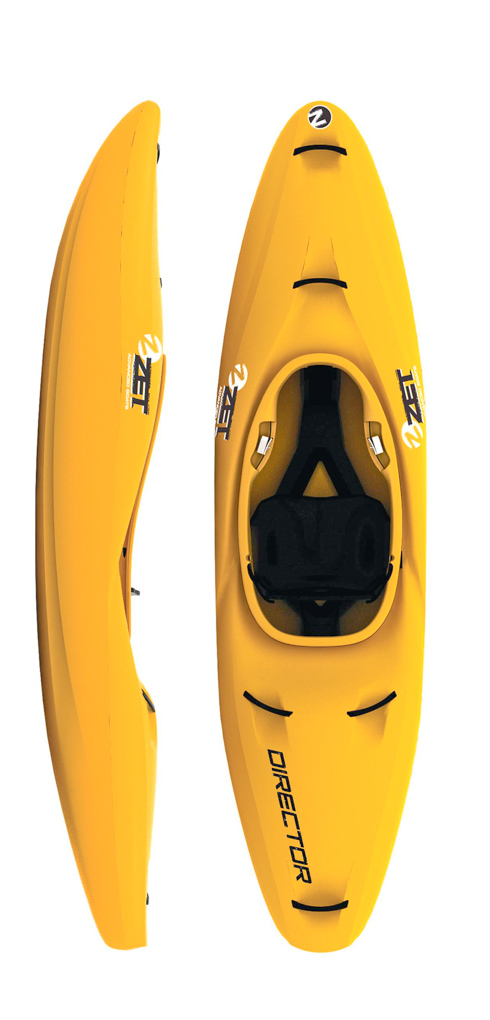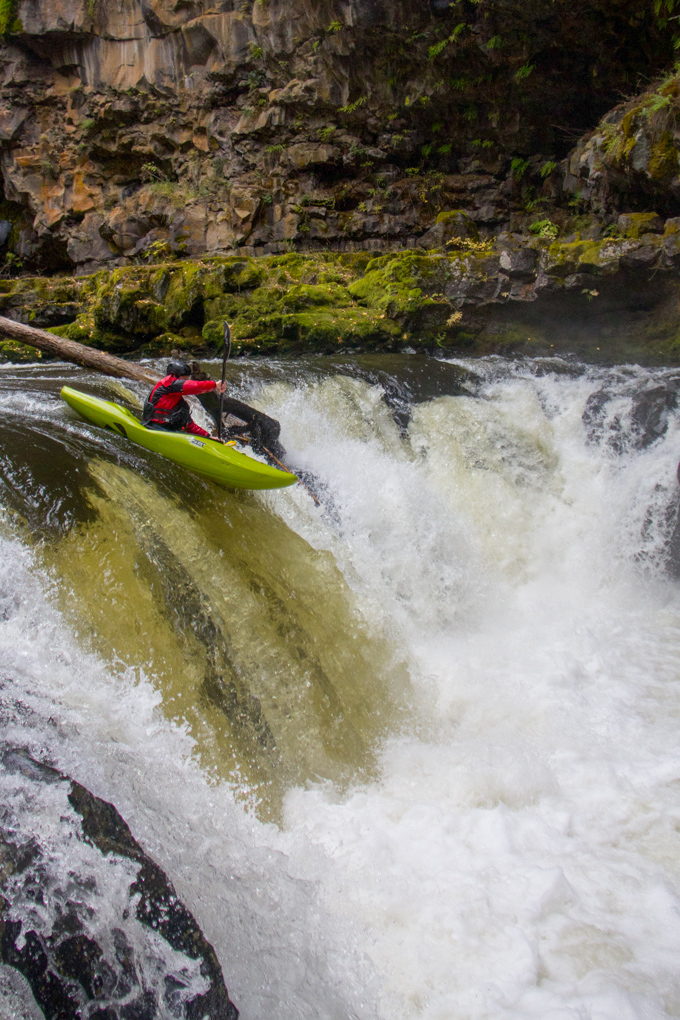
ZET Kayaks Director
Manufacturer specs:
- Length/width: 8’9″/26.7″
- Volume: 95 gallons
- Weight: 46 lbs
- Recommended paddler weight: 165-250 lbs
Reviewer stats:
- 6’2″, 210 lbs
- Shoe size: 11.5
- Inseam: 32″
MSRP: $1199
Test conditions: Low volume creeking, high volume creeking, bigwater, pushy river-running
Test locations: Maine, New York, British Columbia, Washington State
Days Tested: 20
ZET Kayaks are relative new-comers to the whitewater kayak scene in the US, and the Director is their high-volume creek boat. ZET bills the Director as a creek boat and river runner for big paddlers, and those looking for a little more volume for trips requiring more gear or for a little extra buoyancy to stay competitive while racing on creeks.
Design
Unlike most kayak companies, ZET doesn’t just scale one kayak’s design up or down to fit a wider range of paddlers. Rather, they design a different kayak for each target weight range. This means that although the Director is technically the big brother to the Raptor, the design of the Director actually varies significantly from the smaller Raptor.
The Director’s design is unique among high-displacement creek boats. It has a planing hull that runs almost the full length of the boat before rounding near the bow and stern. The Director has a hard chine and an aggressive double edge that starts just forward of the heels and spreads out and softens behind the seat. It is this aggressive edge that really sets the Director apart from the Raptor.
The bow rocker line on the Director starts farther forward than many boats I have paddled recently (e.g., the Liquidlogic Stomper 90, Dagger Mamba 8.6, and Dagger Nomad 8.5), and the stern rocker is relatively flat and low.
Defined edges, a hard chine, and a planing hull can be a recipe for an unforgiving boat. But ZET has combined these features to create a boat that is exciting, dynamic, and downright fun to paddle, though certainly not dead-easy like a Liquidlogic Stomper or Jefe.
One of the key features that ZET incorporated into the Director is a high parting line, which makes the boat significantly more forgiving than the hard chine and defined edge would usually suggest.
The parting line refers to the line that represents the transition from hull to deck, and is often the same as the seam line between the hull and deck molds in manufacturing. When laterally-moving water hits the boat below the parting line, it will move down under the boat, effectively lifting the kayak up in the water. Water that hits above the parting line will move up onto the deck, submerging the deck. A higher parting line, when done right, can make a boat feel more stable and help it stay above the surface in tricky cross-currents. The line on the Jackson Karma is a great example of a high parting line that is done well.
High-Volume Creeking and Big Water
My initial impression of the Director, before ever getting in the water, was that it might provide a relatively precise but taxing experience. Basically I expected a fun yet unforgiving boat. I found, however, that there was a bit more to the story.
The Director excels in rivers with lots of water, and does a great job of giving the paddler control over the boat when rapids involve multiple moves with continuous lines.
I had the most fun in the Director on rivers like the Upper Cheakamus in Whistler, where rapids often involve moving from one side of the river to the other using pushy lateral features to ferry. In these situations, the Director felt nimble enough on edge to make quick course adjustments when I screwed something up, but could hold a line through a curler or cross-current. The Director would tenaciously maintain its angle as long as it was up to speed.
The Director was notably faster than the Mamba 8.6 that I have been paddling recently, and it ranks among the fastest creek boats I have paddled to date. The flat and low stern rocker keeps the Director from dragging its stern through the water, making a longer waterline when the boat is up to speed, whether that be in flatwater or moving water. This surprised me quite a bit, because personal experience (and fluid dynamics) has led me to expect boats with planing hulls to lag a bit behind displacement boats like the Liquid Logic Remix when not planing.
The shallow stern rocker also helps the boat hold its line well when it’s up to speed.

The speed, defined edges, and planing hull of the Director make catching eddies incredibly fun. The faster and more defined the eddyline was, the more fun I had with the Director. The boat planed out quickly and I was easily able to control the exact radius of the eddy turn. The Director was great at carrying speed while approaching an eddyline, and maintaining that momentum into the eddy so the boat cleared the eddyline quickly and under control. This was particularly helpful in maintaining boat angle and control when leaving an eddy with a big ferry ahead. The slalom background of the ZET designer team definitely becomes apparent when catching eddies.
The Director is, however, a bit picky about boat angle coming in and out of eddies. If my boat angle relative to the eddyline was too shallow, it was easy to bounce off the eddyline and miss the eddy completely.
Too steep of an angle meant spinning out prematurely on the eddyline, occasionally preventing me from driving deep into the eddy. When you hit the sweet spot though, the Director felt zippy and responsive, a far cry from the big, slow, and cumbersome traits that its 95-gallon “big boy” spec would suggest.
The Director is a blast on a wave, and surfs better than any creekboat I have used. Again, the planing hull and low stern rocker come into play here, making it easier to catch fast green waves. The boat has enough bow rocker to keep the nose from pearling too badly on steeper waves.
On relatively straightforward big water rivers, like Maine’s Kennebec River, the Director felt a little more cumbersome compared to how it paddled on more dynamic water. It was still more fun to paddle the Director than a boat like the Jefe or Wave Sport Recon on class III wave trains, but there are limits to how sporty a 95-gallon creekboat can feel in less dynamic water. When it comes to big class III water, I think the Director compares favorably to the Mamba 8.6 in terms of performance. For a full-size creekboat it is still pretty darn fun on just about anything.
Boofing
I found the Director to be more forgiving than I expected in most river conditions; however, it is definitely not forgiving when boofing. Anytime I needed to get the bow up, whether it was off a vertical drop or over a hole or wave, it required good technique and perfect timing to guarantee success. As David Spiegel found with the Raptor, getting the boat up on edge a little bit at the takeoff seemed to be the best way to really disconnect from the water. Sometimes that is easier said than done, though. When I occasionally found my attention occupied by something other than boof technique, I didn’t quite get the boof I wanted.
There are two components that make the Director a more difficult boat to boof than most other boats: the low and flat stern rocker and the relatively far forward bow rocker line. The characteristics of the rocker profile that allow the Director to be fast and track well work against it when it comes time to disconnect from the water for a boof. There is a long waterline that takes a longer, later, and more powerful boof stroke to do the same job that a less perfect stroke would do in a Stomper, for example.
The Director is by no means an impossible boat to boof. But if your boof is not well refined or you get lazy from time to time, expect to occasionally pay the price in missed boofs and subsequent hole-rides. At least it surfs well, so you should have an easier time getting out of the hole when you blow the boof.
The relatively progressive bow rocker on the Director allowed me to land drops with the bow dropped slightly down, making a truly flat boof unnecessary. Coming away from the bottom of a drop, the Director does a great job of resisting tail stands and carries speed very well.
Low-Volume Creeking
While the Director shines in rivers with plenty of water, I found it less well suited to low volume creeks and rivers.
In rivers with less water, speed is not as beneficial of a characteristic because there often isn’t enough water or space to really get up to speed between moves. Having the ability to go fast and choosing not to is fine, but it was occasionally a detriment to come planing out of a drop at top speed when I really wanted to keep things slow and spin the boat to avoid the next rock.
The hull design is also not optimized for lower volume paddling. The aggressive edges tended to catch harshly on some of the shallow slides and rapids I regularly paddle in New England, the challenge of boofing the Director is amplified even more on shallow rock lips, and the flat planing hull of the Director did not allow for very smooth lean correction when smearing off of rocks.
I still had plenty of fun paddling the Director on low water runs, but if you live in a part of the world that doesn’t have a plethora of higher volume rivers and creeks, or you just have a preference for running low-volume, the Director may not be the best boat.
NEXT: Sizing, Features, and More…

Hey Thomas –
I think you nailed it on this review. I have had a Director for 2 years and love this boat for the NF Payette and self supports. That said, it low volume performance is challenging at times. I would love more boof-ability, but that would probably change the boat in a way that would alter its other performance characteristics.
None the less, I have bought a second one as a backup because I plan on paddling this boat for several years!
Drew